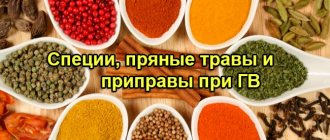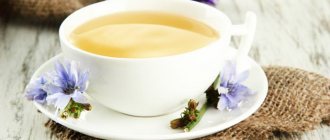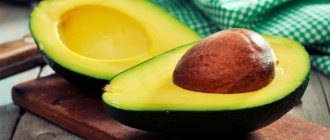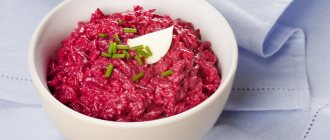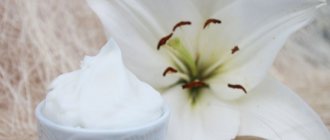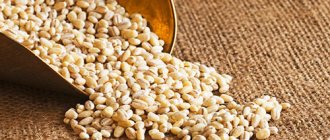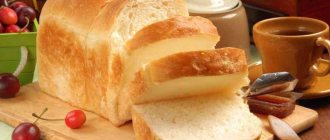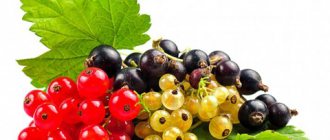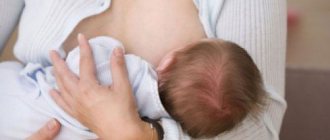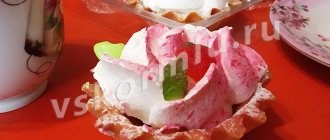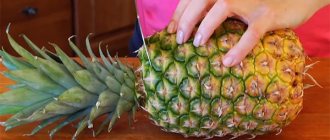Is it possible to eat crabs while breastfeeding? Can a nursing mother eat seafood?
On the eve of the holidays, many nursing mothers are salivating from the abundance of prepared dishes, and there is nothing surprising here.
A strict diet can lead to nervous tension for the mother, so occasionally it’s worth pampering yourself with salads, but is it possible to have crab salad while breastfeeding? After all, many people love it so much that it is difficult to find a person indifferent to it, but first mothers should figure out whether it will cause harm during lactation.
A product that imitates crab meat - crab sticks - has recently become quite popular. It has proven itself excellent both in various salads in its natural form and in heat treatments, for example in baked hot appetizers.
It is also impossible not to note its acceptable price category, in contrast to expensive seafood.
The classic recipe for crab salad consists of: crab sticks, canned corn, eggs and mayonnaise. Many people add other ingredients if desired, but we will evaluate the benefits or harm during breastfeeding in this combination. Before drawing conclusions, you need to know what the main components of the salad consist of.
Crab sticks that imitate expensive seafood are created artificially. For their production, inexpensive crushed white fish or surimi is used - fish protein, which is processed in a special way.
- To obtain it, fillets of hake, pollock or blue whiting are ground.
- Next, the fish puree is washed many times with cold water, after which the soluble components are expelled from the mass, resulting in pure protein.
- With certain functions of production equipment, excess moisture is extracted from the contents, large blocks are formed, which are subjected to shock freezing.
- After making surimi, it is sent to the next production cycle - factories for imitation seafood.
- Due to salt, dyes and synthetic flavors, crab sticks are formed according to a characteristic pattern.
Sticks made from surimi have a multi-layer structure, and can be unrolled if desired. The nutritional value of this product leaves much to be desired, since besides protein there is no other benefit.
This is due to the fact that double freezing contributes to the loss of all vitamins and microelements found in white fish.
Even the best high-quality crab sticks contain protein, 1-2% vitamins and microelements, preservatives, synthetic colors and flavors, as well as flavor enhancers.
It is very sad, but in general it is very difficult to find even such crab sticks among the assortment of store shelves.
Most manufacturers further reduce the cost of the product manufacturing process by only using a combination of soy and egg whites, starch, synthetic dyes, flavors, preservatives and flavor enhancers.
What can you say about nursing mothers, because even an ordinary person should refuse to use them.
Many people know that the combination of crab sticks and canned corn is successful. It is one of the most popular and delicious.
In the absence of allergic reactions to seafood in the mother, high-quality crab sticks will not cause too much harm, which cannot be said about canned corn, which is too allergenic and instantly causes increased flatulence in the baby.
And in combination with synthetic additives, which manufacturers use in any case, this is simply an “atomic bomb” for a fragile body.
You can try corn at the initial stage, one teaspoon at a time, and only if the child has no allergic reactions, digestive disorders or colic. Otherwise, it is necessary to completely abandon or at least delay its use.
Many experts advise nursing mothers to consume boiled chicken eggs. In general, infants respond well to egg whites, provided, of course, that the product is fresh and properly prepared. Therefore, the risk of an allergic reaction to it will be minimal.
However, eggs must be introduced into the diet with caution.
- Firstly, not earlier than the baby is one month old, and in the amount of 1⁄4 eggs. The dosage is gradually increased and in the absence of any undesirable reactions from the baby, the mother can eat a maximum of 2 boiled eggs per week.
- Secondly, if the baby is hypersensitive to many foods, then it is better to exclude this one from his diet.
Crab salad when breastfeeding with eggs, of course, will seem very tasty and harmless, but in practice this is not the case. It can cause many problems for both mother and child.
Mayonnaise
Everyone knows what a large amount of chemicals industrial mayonnaise contains. And what do you think, if it is dangerous for an ordinary healthy person to eat, then what can we say about a nursing mother?!
One has only to look at the composition indicated on the label to appreciate the complexity of the situation.
The presence of raw eggs alone can provoke allergic reactions, and in the worst case, salmonellosis. This is not just harmful, but also life-threatening for an adult, and even more so for a child.
After reading this article, many should have answered the question themselves: is it possible to have crab salad while breastfeeding?
According to experts, all components of this dish are complex and unsafe, as they are stuffed with various synthetic additives.
If a nursing mother really wants it, then each ingredient must be introduced into the diet separately, since the salad in its entirety can immediately provoke digestive disorders and serious liver problems in the child.
Pediatricians' position
During breastfeeding, the following are allowed:
- cook;
- stew;
- bake in a sleeve or foil.
Crab sticks, which actually do not contain a single gram of crab meat, are made from low-value varieties of small fish. To give the product taste and aroma, manufacturers add flavorings and other chemicals to it. Just look at the price of red dye! An additional danger is that this product is consumed by the majority without heat treatment.
Please note: crab sticks are included in prohibited foods when breastfeeding.
If you really want to eat a crab stick, then choose a good product, and pay attention to the expiration date. Be sure to heat-treat and do not eat the whole pack at once. One thing will be enough. Perhaps this will be enough to stop the hunt. Be sure to monitor how your child behaves after such lunch.
If there is a new addition to your family, this is not a reason to give up your usual delicacy. And this is not just a fad, it is useful for both mother and baby. Squid, shrimp, and octopus tentacles contain a lot of useful substances.
For example, 100 grams of shrimp contains only 95 kcal, 19% protein, 2.2% fat and 0 carbohydrates. The same amount of crab, for comparison, contains 96 kcal, 16% protein, 3.6 fat and not a single carbohydrate. The composition of mussels is not much different from shrimp and crabs: 50 kcal, 9% protein, 1.5% fat, no carbohydrates. Lobsters and tender scallops have similar numbers.
Sea kale (kelp seaweed) is a valuable source of iodine. of this essential microelement can only compete with the soft walnut peel. Surprising fact: heat treatment has no effect on the amount of iodine. Sea kale is also rich in fluoride, fiber and vitamins.
Raki is another healthy product that is allowed for a nursing mother after 6 months after giving birth. Its main advantage is the normalization of digestion. Experts say: if a woman’s digestion is normal, then the baby will not suffer from colic.
The lack of nutrients affects her skin, hair, nails and overall health. She needs strength more than ever. Seafood will save the situation, but it should be introduced into the diet very carefully.
As mentioned above, they can cause dermatosis.
Complementary feeding of the child should occur gradually. As for seafood, all kinds of shrimp, octopus tentacles and crabs, experts say that dishes from these representatives of marine fauna may be on the baby’s menu, but you should not get carried away with them. In no case do crab sticks belong to seafood - they definitely should not be included in the children's menu
Every mother wants to feed her baby something tasty and healthy. From about two years old, a child can be offered kelp, since seaweed does not cause allergies. Give seaweed no more than twice a week, 30-50 g.
But a child can be introduced to invertebrate marine animals no earlier than three years of age. The daily portion of seafood delicacies should not be large: for a child under 5 years old, 30-50 g per day will be enough, and for those aged 5 to 10 years - 80-100 g. Seafood is included in a child’s diet no more than once a week (replacing them fish or meat).
Is it possible to eat crab sticks while breastfeeding?
During the period when a woman is breastfeeding, she constantly has to think about how healthy and safe what she eats will be for the child.
It is necessary to constantly monitor the baby, monitor the reaction of his body after the mother has eaten this or that product. It would be more rational to become familiar with all its features and possible consequences before a nursing woman uses it.
Any woman enjoys eating salads. Some of them add crab sticks to the dish.
What are crab sticks made from?
This product appeals to almost everyone, not only because it has excellent taste. This is also due to the affordability of the price. Indeed, by spending a little money you can buy a tasty and valuable product.
Despite their name, these sticks have nothing to do with crabs. Most likely, they can be classified as fish products, since it is the basis for their production.
Crab sticks are just an imitation of crab meat.
For their production, cod fish, blue whiting, and other species are used. If there are no individual intolerances or contraindications, then it is quite possible to use crab sticks in a woman’s diet.
As for the industrial process of obtaining the product, it consists of several stages:
- The fish fillet is ground until a homogeneous mass is formed.
- Surimi is prepared, which is a special protein. For this purpose, the fish is known to be washed with water many times. As a result of this, everything that can go into solution is removed from it. Natural protein remains in the fish itself. After removing the moisture, it is used to prepare crab sticks.
Is it possible for a nursing mother to have squid?
Compound
The following substances can be found in the product:
- Protein components.
- Very meager amounts of amino acid, mineral and vitamin composition.
- The composition is distinguished by the presence of various preservatives (artificial colors and preservatives are added).
- To improve taste, various flavor enhancers are added.
Ingredients that may cause harmful effects
Of course, a fish base is used to make crab sticks, but it is very difficult to call the product completely natural. After all, to give the product a marketable appearance, various additives are introduced into it.
They are represented by salt, dyes and flavors. Despite the fact that, naturally, food dyes, rather than technical ones, are used, nevertheless, they belong to the group of chemicals.
The same applies to preservatives and flavor enhancers.
Crab sticks and lactation
All chemicals contained in the product will certainly pass into breast milk. It will not come as a surprise that any synthetics are extremely undesirable for babies. All such components can cause allergic reactions. In large quantities, they can have an adverse effect on the digestive tract.
If a woman loved and consumed crab sticks before pregnancy, then this can be done now, but in extremely limited quantities. All this is permissible only in cases where the woman herself does not have any undesirable symptoms after using them.
According to general rules, you should start consuming any new food product during lactation with small quantities.
This will allow you to observe the baby’s reaction and decide whether you can continue using it, gradually increasing the amount of the product, or whether you should completely stop using it.
But even if there are no negative manifestations, a nursing mother still cannot eat crab sticks every day.
Is it possible for a nursing mother to have shrimp?
The benefits of crab sticks for a nursing mother
Any woman can get some benefits from using this product:
- Crab sticks are low in calories, and this will be very useful for women watching their figure. Using them makes it very problematic to gain extra pounds, and they are not needed at all, since during pregnancy, sometimes, there is already an excess of them.
- The protein contained in the product is easily digestible.
This is where, perhaps, all the benefits end, since as a result of intensive washing of the fish, almost all useful substances are washed out of it. It is probably more rational to classify crab sticks as neutral products. They won't do any harm, but they won't do much good either.
Possibility of using crab stick salad in the diet
This salad is called “crab”. If the crab sticks themselves do not cause harm to both the woman herself and her baby, this does not mean that the dish as a whole can exhibit the same properties.
After all, it contains various products, and each of them should be analyzed separately.
For example, mayonnaise can be used as a dressing, but it is clearly not harmless to the child’s body.
Crab sticks go very well with corn. Therefore, in the process of preparing holiday salads, these components are often placed side by side. But they can be used in this combination when the child reaches at least 6 months of age. Corn itself is a product with low allergenic properties.
It does not contain gluten, to which children often have allergic reactions. But, at the same time, it can cause increased formation of gases in the intestines. This can cause colic in the baby.
But, if the baby does not experience any reactions, then it is quite possible for the mother to consume such salads in small quantities.
Whether a nursing woman should eat crab stick salad or whether to ban this dish depends on how the baby reacts to it.
In the absence of negative reactions or suspicions of their existence on the part of the baby, the mother can probably treat herself to such dishes in small quantities.
Moreover, she also needs to expand the menu and gradually make it more varied, since a long-term strict diet can sometimes even lead to a nervous breakdown.
Can a nursing mother eat red fish?
: benefits and harms of crab sticks
Source: https://s1280.ru/mozhno-li-krabovye-palochki-pri-grudnom-vskarmlivanii
What are crab sticks made from?
A popular and affordable product, crab sticks are not related to the crabs themselves. But you can call them a fish product. The sticks are based on white fish that is inexpensive to produce and process: cod (pollock, blue whiting), hake. This fish is allowed to feed women during lactation, unless they have individual contraindications.
Stages of preparing fish base:
- grinding fish fillets to the smallest particles into a uniform mass;
- preparation of a special protein - surimi. To obtain it, the fish is washed several times. During the rinsing process, fresh water removes everything from the fish that can dissolve (salt, etc.). The remainder produces natural fish protein that has not dissolved - surimi. It is used for crab sticks after moisture has been removed.
Are crab sticks harmful?
Despite the fish base, it cannot be said that crab sticks are a completely natural product. They get the look we are used to after salt, coloring and flavoring are added to this base.
And although food colors and flavors are used, they are nevertheless chemicals, as are the preservatives and flavor enhancers used. Therefore, it is impossible to call a product obtained from all ingredients a completely natural product.
And although food colors and flavors are used, they are nevertheless chemicals, as are the preservatives and flavor enhancers used. Therefore, it is impossible to call a product obtained from all ingredients a completely natural product.
To understand whether crab sticks can be eaten, you must first study the composition of this product. Experts have repeatedly said that they are oversaturated with chemicals that have a negative effect on the human body.
Important! Crab sticks are harmful due to their composition, which contains virtually no natural substances.
Because of this feature, the product should not be given to children or consumed during pregnancy or breastfeeding. The components in the composition can have a negative impact on the child’s fragile body and negatively affect its development.
The following factors also explain why you should not eat crab sticks:
- In case of exacerbation of diseases of the digestive system, the use of the product leads to a deterioration in the patient’s condition.
- Crab sticks lead to intestinal irritation.
- A low-quality product can cause serious poisoning, which poses a direct threat to human health and life. To avoid such consequences, you should purchase sticks with a good shelf life. Ideally, they should be sold in a vacuum, and not by weight.
The answer to the question of whether crab sticks can be eaten will be positive only if you eat them occasionally in limited quantities. Then the product will not cause any particular harm to health. But things are different if you introduce it into the diet on a permanent basis.
Are crab sticks harmful?
Unfortunately, the popularity of crab sticks has led to manufacturers seeking to increase their production while reducing costs. Therefore, in stores you can see offers that do not have a fish base at all. They replace the fish protein that surimi is made of with a mixture of egg and vegetable soy proteins.
But such a mixture will clearly harm the baby! Therefore, if you decide to treat yourself to a dish that includes crab sticks on a holiday, carefully study the packaging. By purchasing those made from fish meat, you will reduce their harmful effects on the baby.
- Safety. The components of salads must be previously introduced into the mother’s diet in order to monitor the baby’s reaction.
- In the first month, it is better not to eat multi-ingredient dishes, as this food may be heavy for the baby.
- Up to 3-4 months, salads should be prepared from ingredients that are thermally processed.
- Products can be boiled, stewed or baked. Do not fry under any circumstances!
- Fresh vegetables and fruits can appear in the mother’s diet only when the colic period ends. High fiber foods increase abdominal pain.
- Raw fruits and vegetables should be washed well.
- To maintain lactation, eat nuts, cheese, carrots, and dairy products.
- It is better not to choose recipes with canned ingredients.
- A nursing mother needs to limit her salt intake so that there is no swelling and the taste of breast milk does not change. Dried seaweed is suitable for this.
- If the recipe contains eggs, make sure your child is not allergic.
- Ketchup and mayonnaise should not be consumed while breastfeeding.
So, crab stick salad is allowed during breastfeeding. However, you should carefully monitor their quality and eat them rarely. Don't be fooled by the fact that they contain valuable fish protein. It will be much healthier to eat baked or boiled fish.
- grinding fish fillets to the smallest particles into a uniform mass;
- preparation of a special protein - surimi. To obtain it, the fish is washed several times. During the rinsing process, fresh water removes everything from the fish that can dissolve (salt, etc.). The remainder produces natural fish protein that has not dissolved - surimi. It is used for crab sticks after moisture has been removed.
Harmful Ingredients
And although food colors and flavors are used, they are nevertheless chemicals, as are the preservatives and flavor enhancers used. Therefore, it is impossible to call a product obtained from all ingredients a completely natural product.
How to lose weight after childbirth?
Many women after childbirth face the problem of excess weight. For some, it appears during pregnancy, for others, after childbirth.
- And now you can no longer afford to wear open swimsuits and short shorts...
- You begin to forget those moments when men complimented your flawless figure...
- Every time you approach the mirror, it seems to you that the old days will never return...
But there is an effective remedy for excess weight! Follow the link and find out how Anna lost 24 kg in 2 months.
We invite you to read: How to lose weight while breastfeeding: important rules. Is it possible for a nursing mother to drink tea for weight loss during breastfeeding?
Harm to the product
Unfortunately, the popularity of crab sticks has led to manufacturers seeking to increase their production while reducing costs. Therefore, in stores you can see offers that do not have a fish base at all.
They replace the fish protein that surimi is made of with a mixture of egg and vegetable soy proteins. In combination with starch, it is possible to create a consistency identical to that from which sticks are usually made. And the taste is ensured by an increased dose of flavoring.
Such products can be made cheaper, so they are purchased first.
Is there any benefit?
Are crab sticks made from surimi healthy? Even if you purchased a fairly high-quality product (these are sticks in which the amount of surimi is not lower than 40-45%), neither pediatricians nor nutritionists will say this. However, they have a certain appeal:
- This is a low calorie product. Eating 100 g of sticks, a person receives only 70-80 kcal;
- fish protein is easily digestible by humans.
The product has no other useful characteristics. Due to repeated washing of microelements and vitamins, it contains too few, only 1-2%.
Therefore, a small amount of crab sticks during lactation will not harm, but will not bring much benefit either.
If a nursing mother takes part in preparing a feast or becomes a participant in it, she should be especially attentive to salads, because the composition includes not one product, but various combinations of them.
In many families, crab sticks are usually used to prepare a salad, which is called “Crab”.
Crab salad attracts housewives with a minimum of ingredients and ease of preparation. In addition to chopsticks, you will need eggs, a jar of canned corn and mayonnaise for dressing. Let's see how babies react to these components.
Consequences of a child eating classic crab salad ingredients:
- canned corn: causes allergic reactions, leads to flatulence, disorders of the digestive system, food colic;
- chicken eggs: are an allergen.
Mayonnaise: a fatty sauce, into which modern manufacturers often introduce chemical additives, is not recommended for breastfeeding.
Now we see that an ordinary crab salad is not the best delicacy that a nursing woman can find on a holiday table. But individually, its ingredients can be gradually introduced into your diet.
The optimal time to try crab salad is only when the baby is over 6 months old.
If mommy really wants crab sticks, during lactation it is better to give up the traditional salad with corn and add them to vegetable salads. Such salads can be eaten as a separate dish, or with an additional ingredient.
Recipe No. 1
Bell pepper, cucumber, tomato can be combined with crab sticks. The result is a delicious, nutritious, healthy salad. The main condition: do not season it with mayonnaise!
Recipe No. 2
Shredded cabbage, carrots and grated apple, seasoned with vegetable oil, make a light and tasty salad. White cabbage, carrots, apples are plant foods that can be included in a woman’s diet during lactation. This applies to everyone, with the exception of those mothers who have individual intolerance to vegetables and fruits. Sticks can be combined with vegetables.
Recipe No. 3
The salad, which is prepared using boiled rice, eggs, crab sticks, and fresh herbs, is also suitable for nursing mothers. Some recipes recommend seasoning the ingredients of this salad with mayonnaise after chopping them. But not bought in a store, but prepared yourself.
Think before you do it! Of course, homemade mayonnaise will not contain those chemicals that are included in the finished sauce to enhance taste and long-term storage. But fresh eggs are cause for concern.
Not only can they be an allergen, but they are also used without heat treatment. In this form, they can cause serious illness. It is better if you replace homemade sauce with low-fat sour cream.
Pediatricians' position
Pediatricians say that nursing mothers need to adhere to a strict diet in the first months after childbirth. Despite all the apparent benefits of the nutrients that seafood contains, they can also be harmful. It is clear that shrimp, squid and crabs are taboo. What seafood can you eat during lactation?
Seafood includes:
- squid;
- crayfish;
- scallops;
- shrimps;
- shellfish;
- seaweed;
- other.
Important! All these seafood can be consumed by a nursing mother, but only under certain conditions.
When the baby turns six months old, the strict diet is relaxed. A woman is allowed to introduce new foods into her diet, including sea “cocktail”. This should be done very carefully, as some representatives of marine fauna can cause allergies in children.
The child may be covered with red, scaly spots that are very itchy. Childhood diathesis is a very common and harmless phenomenon, but it is best avoided.
It has been proven that not only foods, but also their processing can negatively affect the digestion of a baby who is fed breast milk. If boiled potatoes are harmless, then fried ones can have a negative effect on the baby. The situation is similar with seafood.
Please note that all prepared dishes should not contain hot spices, red pepper, or garlic. It is acceptable to use greens, for example, dill, which has a good effect on the digestion of the child and mother. The ideal option is creamy seafood soup seasoned with cream.
Recipe No. 3
Is it healthy or not - can a nursing mother eat crab sticks?
In the last decade, crab sticks have become a very popular product.
It is used for preparing salads and other dishes, replacing expensive seafood.
Sometimes it is so difficult to resist without trying traditional salads.
But is there any benefit for a nursing mother from this product? Let's discuss it in this article.
What are crab sticks?
Crab sticks appeared on sale relatively recently.
Unfortunately, there is no real crab meat in this product.
To prepare the delicacy, surimi meat is used as a basis - low-value white fish (blue whiting, pollock, hake, etc.).
Cod and some tropical fish can be used to produce sticks.
The fish is processed into surimi no later than 6-10 hours after catching.
History of surimi product production
In the 1970s, the shortage of natural crab meat in Japan increased, and prices rose.
Chefs are forced to develop a recipe that imitates crab meat.
They call it “Kani-Kamaboko” - fish fillet with crab.
Within a couple of years, the product gained wild popularity.
Over the course of 10 years, a crab stick industry has emerged in the country.
Not only crab meat is imitated, but also the following products:
- squid;
- lobsters;
- shrimp tails;
- sea scallops.
To provide the new industry with raw materials, the Japanese developed industrial technology for making surimi from freshly caught fish.
Crab sticks - a Japanese invention
In the late 70s, China, South Korea and other countries in southeast Asia built a large number of factories.
In the 1980s, the first sticks appeared in France in the form in which consumers are accustomed to seeing them. Other products were not in such demand. Japanese enterprises became the first exporters. Dozens of kamaboko factories are appearing in America. In the USSR, the first plant was built in Murmansk.
To provide the global industry with raw materials, onshore plants are being actively developed in Canada and the USA. Main industrial species: hake, pollock.
In the 1990s, many countries in Western and Eastern Europe began to consume crab sticks in large quantities.
Over time, the quota for cod species is reduced, and surimi begins to be produced from other species of marine fish.
The sticks are separated according to quality: along with a high-quality product, a low-quality one is produced, in which fish protein is simply replaced. The CIS countries tried a product of dubious quality.
In the 2000s, sticks become the most common product. It’s not a problem to find them in any store, even the smallest one.
Manufacturing technology
Crab meat is imitated artificially. This affects the cost of the product. So it was made publicly available.
The cost of 1 kg of sticks is 50-60 rubles. The wholesale market offers them at a price of about 100 rubles.
To obtain surimi, white fish fillets are washed many times with water (fresh, chilled). After such manipulations, there are no soluble components left in the meat, but pure protein is obtained.
Chilled crab sticks
Excess moisture is removed using a centrifuge. Next, the mass is formed and sent for blast freezing. Surimi is transported to factories for the production of products that imitate crab meat.
Automated lines roll out the mass into a thin layer, cut it into rectangles, and roll it into rolls. Crab sticks take on their usual appearance and are filled with flavors, dyes, salt and other additives. Minced fish takes up approximately 45-50% of the volume, minimum 25%.
Surimi minced meat does not have its own rich taste. For this reason, manufacturers use natural or nature-identical additives. For example, monosodium glutamate (E-621), carrageenan (E-410).
To imitate the color of crab meat, natural dyes are used: carmine or paprika. To stabilize the color and improve the consistency of the product, diphosphate and sorbitol are added.
To open your own production of this product, you will need 5 million rubles. Most of the funds will be spent on the purchase of equipment for production, as well as refrigeration units.
Equipment for the production of crab sticks is imported from China. The line includes:
- machine for grinding frozen products;
- mixer for preparing dye;
- mass kneader;
- molding machine;
- formation press;
- coagulator;
- cutting and rolling machine;
- wrapping machine;
- packaging machine;
- sterilizer;
- cooler, etc.
A cold storage facility is also required to store raw materials. In the room where finished products are stored, the temperature should be 2-6°. Crab sticks can be stored frozen for 6 months.
Is there any benefit?
Anyone who has tried this product at least once has noticed that the sticks have a layered structure and can be easily “unwound.”
Imitation crab meat has virtually no nutritional value, since the production technology involves repeated freezing.
The vitamins and microelements that were originally in white fish are lost.
The composition of even the highest quality surimi or chopped white fish product contains the following components:
- artificial flavors and colors;
- flavor enhancers;
- protein;
- a small amount of amino acids, vitamins and microelements.
Can a nursing mother have crab sticks?
Whether there is a product made from surimi or not is a personal matter for each woman.
You will not hear any recommendations from any doctor to eat such a product.
The child may have a severe allergic reaction and malfunction of the digestive system.
If the child is already six months old, you can return to the diet before pregnancy (naturally, it should not be harmful).
Then it is permissible to eat crab sticks, but rarely. Monitor your child's reaction: eat half the product and observe the reaction for 24 hours. In case of allergies or diarrhea, discontinue this product immediately.
It is best to buy sticks from proven, well-known manufacturers. The packaging must “tell” you about the composition and expiration date.
It is dangerous to buy a weight product, since there is no such information on it. When purchasing a product, make sure that the packaging is not damaged and that it has not been frozen.
Crab stick salad for breastfeeding
The classic salad includes chopsticks, canned corn, eggs and mayonnaise. If a child does not have an allergy to each product separately, then most likely, if they are combined, it will not occur either.
A few principles for preparing salads while breastfeeding:
- Safety. The components of salads must be previously introduced into the mother’s diet in order to monitor the baby’s reaction.
- In the first month, it is better not to eat multi-ingredient dishes, as this food may be heavy for the baby.
- Up to 3-4 months, salads should be prepared from ingredients that are thermally processed.
- Products can be boiled, stewed or baked. Do not fry under any circumstances!
- Fresh vegetables and fruits can appear in the mother’s diet only when the colic period ends. High fiber foods increase abdominal pain.
- Raw fruits and vegetables should be washed well.
- To maintain lactation, eat nuts, cheese, carrots, and dairy products.
- It is better not to choose recipes with canned ingredients.
- A nursing mother needs to limit her salt intake so that there is no swelling and the taste of breast milk does not change. Dried seaweed is suitable for this.
- If the recipe contains eggs, make sure your child is not allergic.
- Ketchup and mayonnaise should not be consumed while breastfeeding.
So, crab stick salad is allowed during breastfeeding. However, you should carefully monitor their quality and eat them rarely. Don't be fooled by the fact that they contain valuable fish protein. It will be much healthier to eat baked or boiled fish.
on the topic
Source: https://momjournal.ru/kormlenie/grudnoe-vskarmlivanie/mozhno-li-kormyashhej-mame-krabovye-palochki.html
Is there any benefit?
The product has no other useful characteristics. Due to repeated washing of microelements and vitamins, it contains too few, only 1-2%.
Surimi crab sticks usually have a layered structure - they can be carefully “unwound”. The nutritional value of imitation crab meat is minimal - apart from protein, the sticks contain practically nothing useful, since the technology for making surimi and repeated freezing of the finished product leads to the loss of vitamins and microelements originally contained in white fish.
The highest quality crab sticks, made from surimi or minced white fish fillets, contain:
- protein;
- a meager set of amino acids, trace elements and vitamins;
- preservatives;
- artificial colors and flavors;
- flavor enhancer.
It can hardly be recommended to include this product in the menu of a nursing mother, since all the “chemicals” will inevitably end up in breast milk and the baby’s body. It should also be taken into account that Chinese products that arrive en masse on Russian shelves are often not made from surimi.
They include:
- soy protein;
- starch;
- egg white;
- artificial colors and flavors;
- preservatives and flavor enhancers.
Even healthy adults, not only women during lactation, should not consume such products. In an infant, this combination of ingredients can cause a severe allergic reaction, serious disruption of the digestive system, and damage to internal organs.
Sea kale during breastfeeding
Then boil the eggs until hard and cut them into 4 pieces. All ingredients are mixed, seasoned with oil and salt. The cabbage is washed, divided into inflorescences, poured with boiling water and cooked until tender in salted water.
The finished cabbage is placed on a dish, poured with sauce and decorated with herbs. Lettuce leaves can be used as a garnish. The zucchini is washed, the peel and seeds are removed, and chopped into small cubes. Separately, grate Parmesan cheese and grind cottage cheese.
These ingredients are mixed and lettuce leaves are added.
Separately, you need to prepare a dressing; for this, olive oil is mixed with soy sauce and lemon juice. The dish is seasoned. These delicious vegetable salads will be an excellent addition to your daily diet while breastfeeding. They can be eaten for lunch and dinner.
In this case, you should monitor the condition of the newborn, especially if you are trying a product for the first time. During lactation, it is forbidden to consume smoked products, spicy, salty, fried, and fatty foods.
But even without them you can cook something original.
Boiled fish is cut into strips, tomatoes are cut into 4 parts. The ingredients are mixed, torn lettuce leaves are added, and seasoned with a mixture of olive oil and lemon juice. The apple is peeled, seeds removed, and cut into cubes.
The meat is boiled in salted water and separated into fibers. Mix the ingredients, add lettuce leaves, season with olive oil and lemon juice. The salad is torn into pieces and placed on a plate.
Peel the tomatoes, remove the seeds, cut the pulp into small cubes and lay out the next layer.
The greens and onions are chopped and a third ball is made. Then lay out boiled shrimp, grated cheese, and then an egg mashed with a fork. Then mix soy sauce, balsamic vinegar and vegetable oil.
The salad is dressed and topped with shrimp. Boiled chicken meat is separated into fibers, the bread is cut into cubes and dried in a frying pan without oil so that they are golden brown.
The salad is washed, dried, torn into pieces and placed on a plate.
Sesame seeds are fried in a dry frying pan for 2 - 3 minutes. Then follows a layer of meat, crackers, cheese.
The dish is seasoned with oil and sprinkled with sesame seeds. Vegetables are boiled and chopped. The apple is peeled, cored and grated. Fresh herring is skinned, bones removed and cut into cubes. Then finely chop the onion. Then they lay out all the ingredients in balls: fish, onions, potatoes, carrots, apples, beets.
Each layer is smeared with homemade mayonnaise. The beet salad is ready!
Green country
This salad is ideal for nursing mothers. Salads for nursing mothers should contain as many healthy and nutritious substances as possible. Carcinogens must be absent or present in minimal quantities.
A nursing mother's dinner should be light and easily digestible. Green Country salad is of German origin. It is seasoned with the most beneficial olive oil, it does not weigh down the dinner. It only takes 40 minutes to prepare dinner.
Any product can be replaced with the one you have.
Ingredients for preparing the salad:
- chicken fillet 250 grams (you can use healthy turkey meat);
- two green apples;
- two avocados;
- half a lemon;
- lettuce leaves (bunch);
- olive oil (can be replaced with vegetable oil);
- salt;
- parsley dill.
Salad preparation steps:
- The process of preparing salad components. Chicken meat should be washed in cold water. Place the meat in a suitable container with water (broth), then boil. After the water boils, drain it and add cold water again, then boil the chicken until tender.
- After cooking the chicken, you need to cool it. You can simply drain the boiling water and fill the pan with the meat with cold water.
- We cut or tear the cooled meat by hand.
- Now let's start cooking the apples. They need to be washed, then peeled and carefully removed the seeds. It is also better to cut off the apple stalk. Then cut the apple into cubes.
- Wash the lemon and squeeze its juice into a separate bowl.
- Sprinkle lemon juice over the apples. They will not turn black and will acquire a unique bright taste.
- Prepare the avocado.
- Rinse the lettuce leaves with running water and dry. Lettuce leaves need to be torn into separate small pieces.
- You need to combine all the ingredients in a salad bowl. Sprinkle with vegetable oil, salt, mix. After preparing the salad, decorate it with parsley and dill.
IMPORTANT! You should buy soft avocados, not hard ones. Rinse the avocado in cold water, cut into two parts and remove the core. Then remove the peel. You need to cut the avocado into strips. Sprinkle avocado with lemon juice.
A salad for dinner for a nursing mother has important features:
- Instead of lemon, you can use ordinary vinegar.
- The most delicious apples for this salad are “Antonovka” and “Semerinka”.
- Avocado has a very good effect on the gastrointestinal tract and circulatory system. Avocado actively promotes milk production in a nursing woman. You should be careful, it can cause an allergic reaction in the child.
Crab salad for a nursing mother
Salad with mayonnaise is not recommended for consumption during lactation, but if you prepare it yourself and eat it very rarely, it will not harm. Beat the milk and butter for 15 minutes, then add mustard and salt and beat again for 10 seconds.
The result is about ml of sauce. Crab salad is allowed to be consumed 3 months after giving birth. Otherwise, the likelihood of an allergic reaction increases.
Can a nursing mother have crab sticks?
Crab sticks are thawed and chopped. The eggs are boiled, peeled and chopped. The greens are dried, washed, chopped, and the rice is boiled. Chop the onion and eggs. All ingredients are mixed and seasoned with mayonnaise.
Vegetables are washed, boiled, and meat is cooked separately in salted water. After all the components have cooled, they are cleaned and cut into small cubes, poured into a container. Green peas are also added there.
For dressing, you can use mayonnaise or yogurt-based sauce. To do this, add salt and spices to the fermented milk product and season the salad.
Olivier is decorated with greenery. In addition, you can add avocado, apple or soft cheese to the dish. Festive salads for nursing mothers, seasoned with mayonnaise, should be consumed carefully and in small portions. Otherwise, the likelihood of an allergy in the baby increases. Dishes based on fruits and dried fruits should also be consumed with caution.
Is there any benefit?
Surimi crab sticks usually have a layered structure - they can be carefully “unwound”. The nutritional value of imitation crab meat is minimal - apart from protein, the sticks contain practically nothing useful, since the technology for making surimi and repeated freezing of the finished product leads to the loss of vitamins and microelements originally contained in white fish.
The highest quality crab sticks, made from surimi or minced white fish fillets, contain:
- protein;
- a meager set of amino acids, trace elements and vitamins;
- preservatives;
- artificial colors and flavors;
- flavor enhancer.
It can hardly be recommended to include this product in the menu of a nursing mother, since all the “chemicals” will inevitably end up in breast milk and the baby’s body. It should also be taken into account that Chinese products that arrive en masse on Russian shelves are often not made from surimi.
They include:
- soy protein;
- starch;
- egg white;
- artificial colors and flavors;
- preservatives and flavor enhancers.
Even healthy adults, not only women during lactation, should not consume such products. In an infant, this combination of ingredients can cause a severe allergic reaction, serious disruption of the digestive system, and damage to internal organs.
How to introduce it into the diet?
When the baby turns six months old, the strict diet is relaxed. A woman is allowed to introduce new foods into her diet, including sea “cocktail”. This should be done very carefully, as some representatives of marine fauna can cause allergies in children.
The child may be covered with red, scaly spots that are very itchy. Childhood diathesis is a very common and harmless phenomenon, but it is best avoided.
It has been proven that not only foods, but also their processing can negatively affect the digestion of a baby who is fed breast milk. If boiled potatoes are harmless, then fried ones can have a negative effect on the baby. The situation is similar with seafood.
During breastfeeding, the following are allowed:
- cook;
- stew;
- bake in a sleeve or foil.
Please note that all prepared dishes should not contain hot spices, red pepper, or garlic. It is acceptable to use greens, for example, dill, which has a good effect on the digestion of the child and mother. The ideal option is creamy seafood soup seasoned with cream.
Crab sticks, which actually do not contain a single gram of crab meat, are made from low-value varieties of small fish. To give the product taste and aroma, manufacturers add flavorings and other chemicals to it. Just look at the price of red dye! An additional danger is that this product is consumed by the majority without heat treatment.
Source: https://kolyaski-indigo.ru/laktaciya/krabovyj-salat-pri-gv-2.html
Salad according to the classic recipe
In many families, crab sticks are usually used to prepare a salad, which is called “Crab”. Can a woman during lactation fearlessly eat this salad after learning that a small amount of surimi crab meat will not harm the baby? To answer this question, there is not enough knowledge about the benefits and harms of crab sticks. It is necessary to analyze all other ingredients.
Mayonnaise: a fatty sauce, into which modern manufacturers often introduce chemical additives, is not recommended for breastfeeding.
Now we see that an ordinary crab salad is not the best delicacy that a nursing woman can find on a holiday table. But individually, its ingredients can be gradually introduced into your diet. Over time, in the absence of undesirable reactions and consequences in the child, they can be combined by choosing a different dressing for the salad, for example, low-fat sour cream or yogurt. The optimal time to try crab salad is only when the baby is over 6 months old.
Recipe No. 2
Shredded cabbage, carrots and grated apple, seasoned with vegetable oil, make a light and tasty salad. White cabbage, carrots, apples are plant foods that can be included in a woman’s diet during lactation. This applies to everyone, with the exception of those mothers who have individual intolerance to vegetables and fruits. Sticks can be combined with vegetables.
Recipe No. 3
Think before you do it! Of course, homemade mayonnaise will not contain those chemicals that are included in the finished sauce to enhance taste and long-term storage. But fresh eggs are cause for concern. Not only can they be an allergen, but they are also used without heat treatment. In this form, they can cause serious illness. It is better if you replace homemade sauce with low-fat sour cream.
In many families, crab sticks are usually used to prepare a salad, which is called “Crab”. Can a woman during lactation fearlessly eat this salad after learning that a small amount of surimi crab meat will not harm the baby? To answer this question, there is not enough knowledge about the benefits and harms of crab sticks. It is necessary to analyze all other ingredients.
When choosing products for her diet, a nursing mother should keep in mind that at the same time as creating a menu, she is laying the foundations for her baby’s health. This is what you need to be guided by when including or excluding foods from your diet. That is why, despite the fact that crab sticks are not completely prohibited for a woman who is breastfeeding, they are included in the diet gradually and with caution, carefully monitoring the baby’s reaction to this supplement.
Crab sticks taste well with canned corn, which is why salads with these products are among the most popular today. Is it possible for a nursing mother to eat some of this salad on a holiday?
If mom is not allergic to fish and seafood, a small amount of salad with high-quality imitation crab meat will not cause much harm. But it is necessary to monitor the child’s reaction to each of the potentially dangerous ingredients in the salad in advance. Crab sticks and corn should be introduced into the diet little by little and alternately, at intervals of a week.
If the baby exhibits an allergic reaction, increased excitability, or indigestion, experiments must be postponed for a long time or stopped completely, depending on the degree of reaction of the child’s body.
You can try adding corn and crab sticks to the menu of a nursing mother if her baby is at least six months old - until this age, the baby’s digestive system is not sufficiently adapted to new complex foods.
How can corn be harmful? The cereal itself is hypoallergenic - it does not contain gluten, a vegetable protein to which children often exhibit a pronounced reaction. At the same time, corn contributes to increased gas formation. If a child does not experience bloating or colic when a nursing mother eats corn, the product is safe for him.
You should pay attention to the potential danger of canned corn for a breastfed baby: preservatives, flavor enhancers, and dyes negatively affect the baby’s fragile body.
When assessing whether certain foods can be consumed without harm to the baby, a nursing mother must take into account all the risks to the child’s health.
